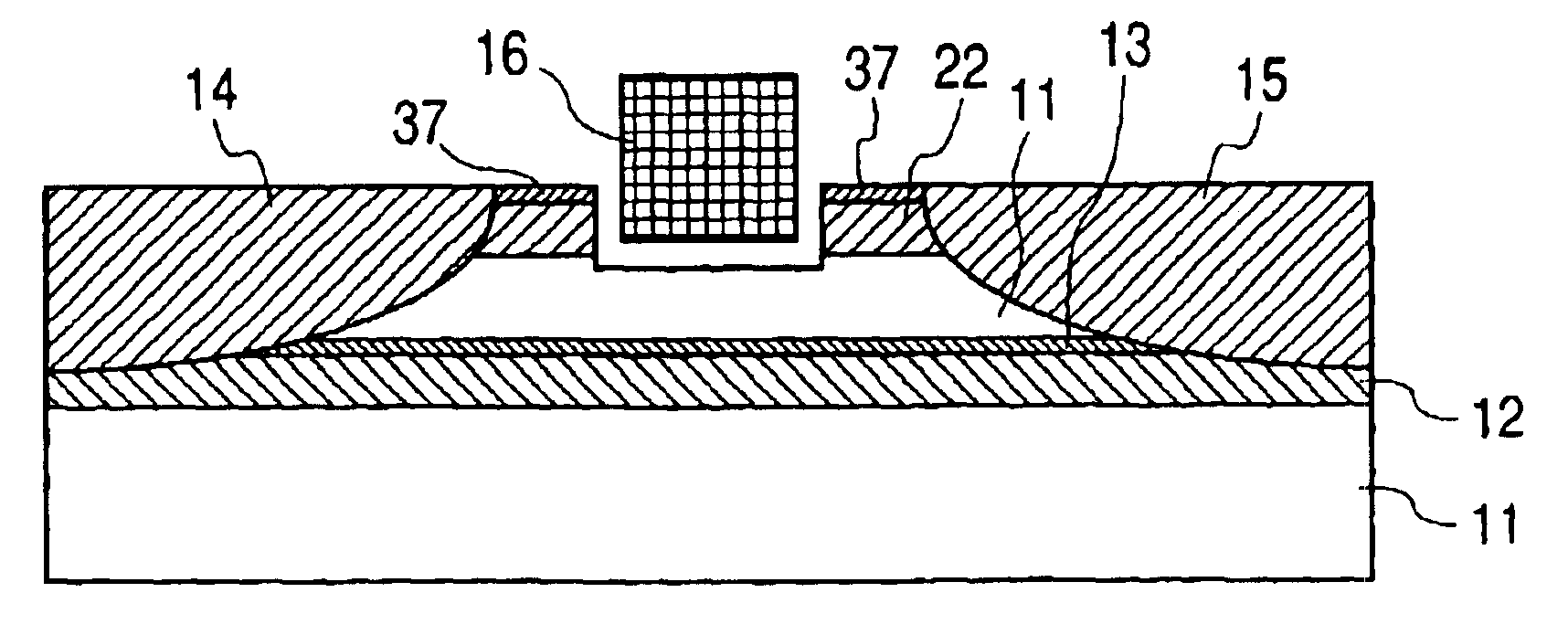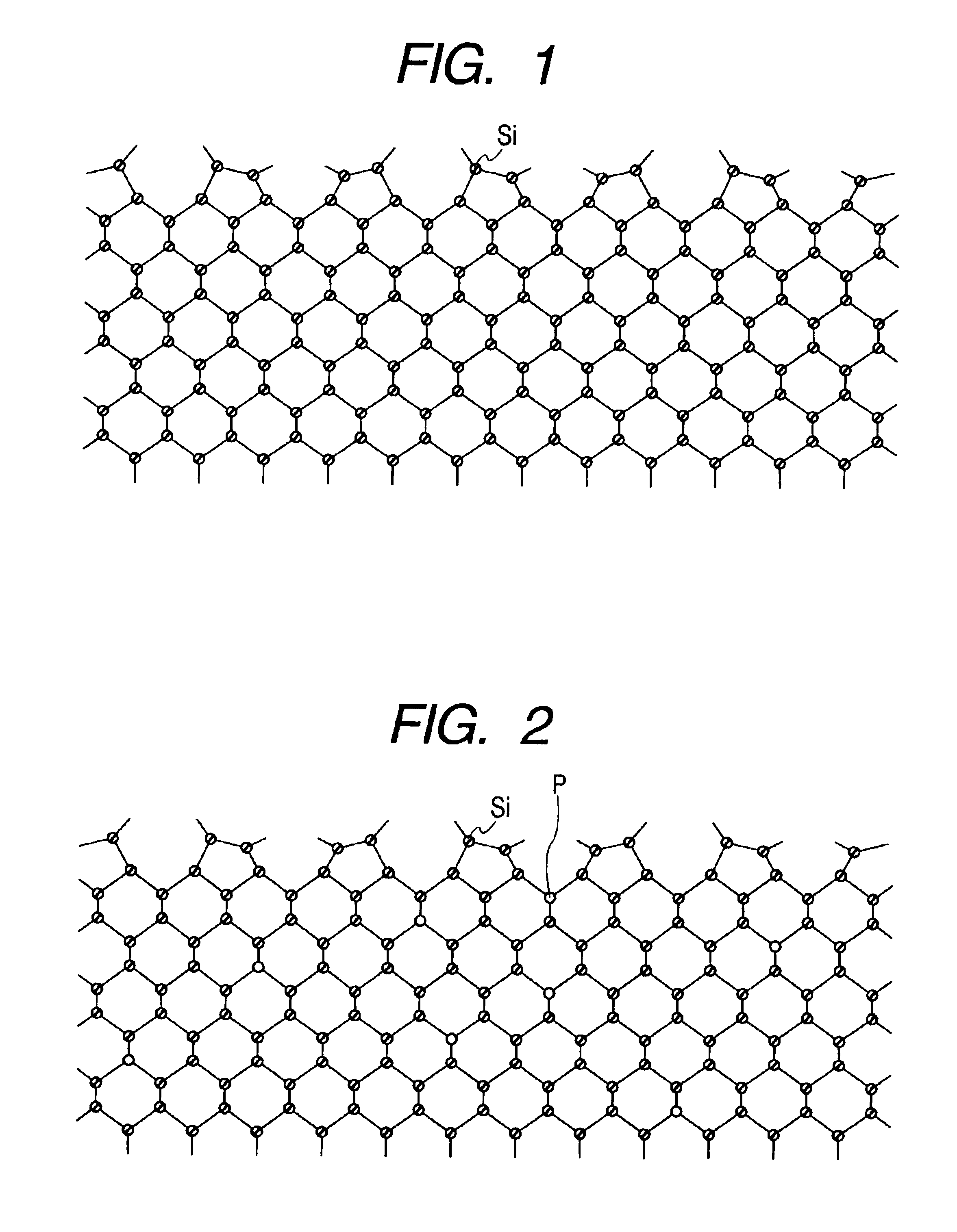Semiconductor device and its production method
a technology of semiconductors and semiconductors, applied in the direction of semiconductor devices, electrical devices, transistors, etc., can solve the problems of undesirable segregation, achieve the effect of sacrificing device characteristics, and reducing the size of mos
- Summary
- Abstract
- Description
- Claims
- Application Information
AI Technical Summary
Benefits of technology
Problems solved by technology
Method used
Image
Examples
example 2
This example demonstrates, with reference to FIGS. 6A to 6D, production of a PMOS in which the n-type delta doping layer functions as the punch-through stopper and the p-type delta doping layers functions as the extensions of the source and the drain.
In the first step shown in FIG. 6A, the substrate prepared in the third step (FIG. 5C) of Example 1 is doped with boron atoms by ion implantation into its surface. This ion implantation forms a p-type doped region 22 (about 0.3 .mu.m thick) with a concentration of about 10.sup.17 / cm.sup.3.
In the second step shown in FIG. 6B, the surface of the substrate undergoes hydrogen termination in the same way as mentioned in Example 1. This hydrogen termination causes boron atoms to segregate in the surface, so that a p-type delta doping layer 23 is formed under the surface hydrogen atomic layer. The p-type delta doping layer 23 has a thickness of one atomic layer and a concentration of about 10.sup.18 / cm.sup.3.
In the third step shown in FIG. 6...
example 3
This example demonstrates, with reference to FIGS. 7A to 7D, production of a CMOS which is a combination of a PMOS and an NMOS, the former having an n-type delta doping layer as the punch-through stopper and the latter having a p-type delta doping layer as the punch-through stopper.
In the first step shown in FIG. 7A, an oxide film 32 for element separation is formed in the silicon substrate 11 in the usual way. The clean surface of silicon is exposed. Phosphorus atoms are implanted into the surface at the right side of the oxide film 32. This implantation forms an n-type doped region 12 which is about 0.3 .mu.m thick and has a concentration of about 10.sup.17 / cm.sup.3. Then, boron atoms are implanted into the surface at the left side of the oxide film 32. This implantation forms a p-type doped region 22 which is about 0.3 .mu.m thick and has a concentration of about 10.sup.17 / cm.sup.3. FIGS. 7A to 7D show only one each of adjacent PMOS and NMOS for simplicity. In an actual semicon...
example 4
This example demonstrates, with reference to FIGS. 8A to 8C and FIG. 9, production of a semiconductor substrate having PMOSs on both sides thereof, each PMOS having an n-type delta doping layer as the punch-through stopper. The PMOSs are formed in the same way as explained in Example 1. FIGS. 8A to 8C correspond to FIGS. 5A to 5C, and FIG. 9 corresponds to FIG. 5E.
In the first step shown in FIG. 8A, the silicon substrate 11 is doped with phosphorus atoms by ion implantation into both sides thereof. This ion implantation forms an n-type doped region 12 (about 0.3 .mu.m thick) with a concentration of about 10.sup.17 / cm.sup.3 on both sides.
In the second step shown in FIG. 8B, the both surfaces of the substrate undergo hydrogen termination in the same way as mentioned in Example 1. This hydrogen termination causes phosphorus atoms to segregate to the surface, so that an n-type delta doping layer 13 is formed under the surface hydrogen atomic layer. The n-type delta doping layer 13 has ...
PUM
 Login to View More
Login to View More Abstract
Description
Claims
Application Information
 Login to View More
Login to View More - R&D
- Intellectual Property
- Life Sciences
- Materials
- Tech Scout
- Unparalleled Data Quality
- Higher Quality Content
- 60% Fewer Hallucinations
Browse by: Latest US Patents, China's latest patents, Technical Efficacy Thesaurus, Application Domain, Technology Topic, Popular Technical Reports.
© 2025 PatSnap. All rights reserved.Legal|Privacy policy|Modern Slavery Act Transparency Statement|Sitemap|About US| Contact US: help@patsnap.com



